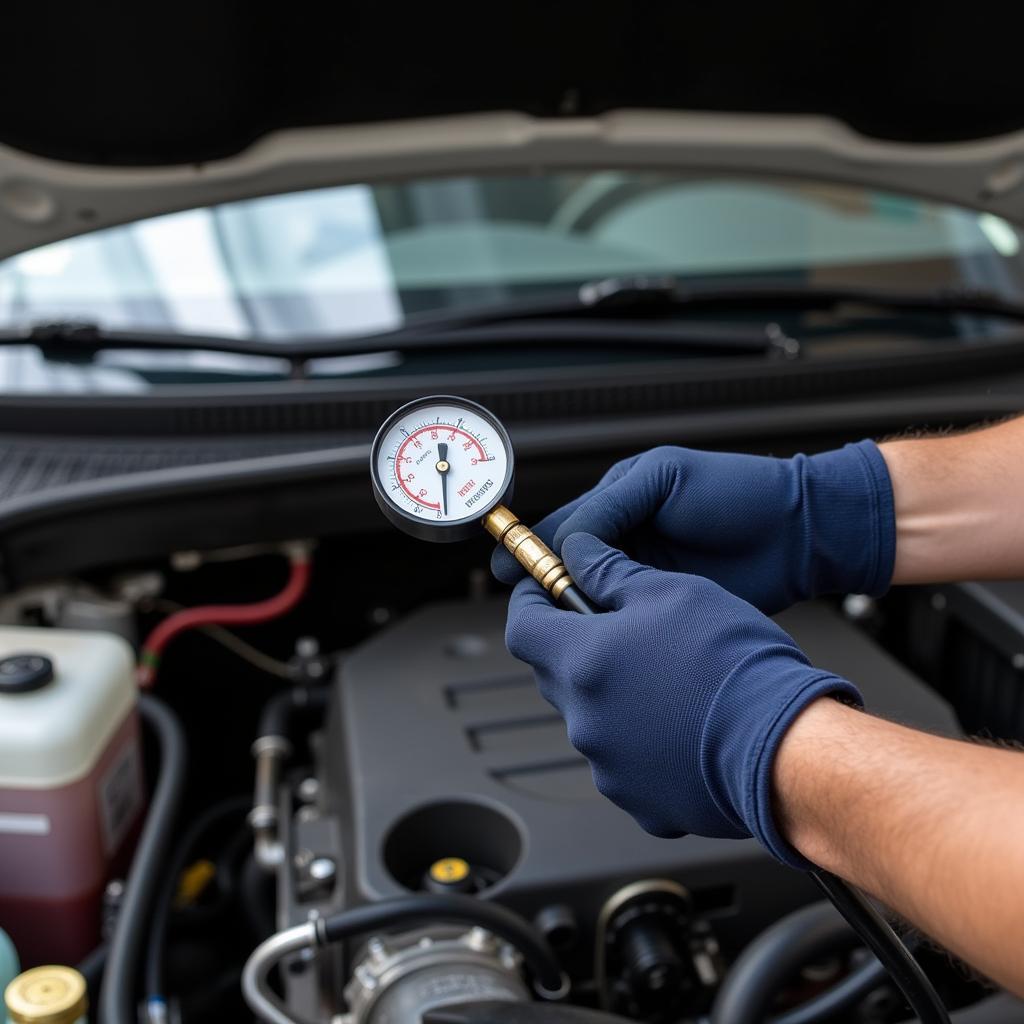Knowing how to put AC coolant in your car is a vital skill for any car owner. Whether you’re noticing warmer air from your vents or just want to ensure your AC system is running efficiently, this guide will walk you through the process, offering a Chris Fix-inspired approach to DIY car maintenance. We’ll cover everything from identifying the correct refrigerant to safely adding it to your system.
Understanding Your Car’s AC System
Before diving into the how-to, let’s understand the basics of your car’s air conditioning system. The AC system relies on refrigerant, a specialized fluid, to absorb heat from the cabin air. This refrigerant circulates through a closed system, changing between liquid and gaseous states to facilitate cooling. Low refrigerant levels are the most common cause of poor AC performance.
How to Identify the Correct AC Refrigerant
Using the wrong refrigerant can damage your AC system. Check your owner’s manual or a sticker under the hood to identify the correct type for your car. Most modern vehicles use R-134a or the newer HFO-1234yf. Never mix refrigerants!
 Adding AC Refrigerant to Car
Adding AC Refrigerant to Car
Gathering Your Supplies
You’ll need a few essential items: the correct refrigerant, a refrigerant dispensing hose with a gauge, safety glasses, and gloves. A leak sealant can be helpful if you suspect a minor leak.
Locating the Low-Pressure Port
The low-pressure port is typically located on the larger of the two AC lines, usually near the firewall. Consult your owner’s manual for the exact location on your specific vehicle. It often has a protective cap.
How to Put AC Coolant in Your Car: Step-by-Step Guide
- Safety First: Put on your safety glasses and gloves. Refrigerant can cause skin irritation and eye damage.
- Connect the Hose: Attach the dispensing hose to the refrigerant can and then to the low-pressure port on your car’s AC system.
- Start the Engine: Turn on your car’s engine and set the AC to maximum cooling and fan speed.
- Add Refrigerant: Slowly add refrigerant to the system, monitoring the pressure gauge on the dispensing hose. Refer to your owner’s manual for the recommended pressure range.
- Monitor and Adjust: Continue adding refrigerant in short bursts, checking the gauge frequently. Avoid overfilling.
 Checking AC Pressure Gauge
Checking AC Pressure Gauge
Troubleshooting Common Issues
If the pressure doesn’t rise after adding refrigerant, you might have a significant leak. In this case, it’s best to consult a professional mechanic. A leak sealant can sometimes temporarily fix minor leaks.
What if my AC still isn’t cold?
Several factors can affect AC performance, including a faulty compressor, clogged condenser, or electrical issues. If adding refrigerant doesn’t solve the problem, further diagnosis is required.
 Car AC Compressor
Car AC Compressor
Expert Insights
“Properly maintaining your car’s AC system, including adding refrigerant when needed, can prevent costly repairs down the road,” says automotive expert, Robert Miller, ASE Certified Master Technician. He further advises, “Always prioritize safety when working with refrigerants, and don’t hesitate to seek professional help if you encounter any difficulties.”
Conclusion
Knowing how to put AC coolant in your car, like Chris Fix often demonstrates, empowers you to maintain your vehicle and keep cool during hot weather. While this guide provides a comprehensive overview, always refer to your owner’s manual for specific instructions for your car model. If you’re unsure about any step, don’t hesitate to contact a qualified mechanic. For further assistance, reach out to us at AutoTipPro at +1 (641) 206-8880 or visit our office at 500 N St Mary’s St, San Antonio, TX 78205, United States.
 Car AC Vent Blowing Cold Air
Car AC Vent Blowing Cold Air
FAQ
-
How often should I add AC refrigerant to my car? It’s generally not a frequent task. If your AC system needs refrigerant regularly, you likely have a leak that needs professional attention.
-
Can I use any refrigerant for my car? No, absolutely not. Using the wrong type can damage your system. Consult your owner’s manual or a sticker under the hood.
-
Is it dangerous to add AC refrigerant myself? While generally safe with proper precautions, refrigerant can be hazardous. Always wear safety glasses and gloves.
-
What if I accidentally overfill the system? Overfilling can damage the compressor. If you suspect overfilling, consult a mechanic immediately.
-
Why is my AC blowing warm air even after adding refrigerant? Other issues, such as a faulty compressor or clogged condenser, might be the cause. Further diagnosis is needed.
-
Where can I buy AC refrigerant? Most auto parts stores sell refrigerant kits.
-
How much does it cost to have a professional add refrigerant? The cost varies, but it’s typically less expensive than repairing a damaged compressor due to using the wrong refrigerant or improper handling.




Leave a Reply